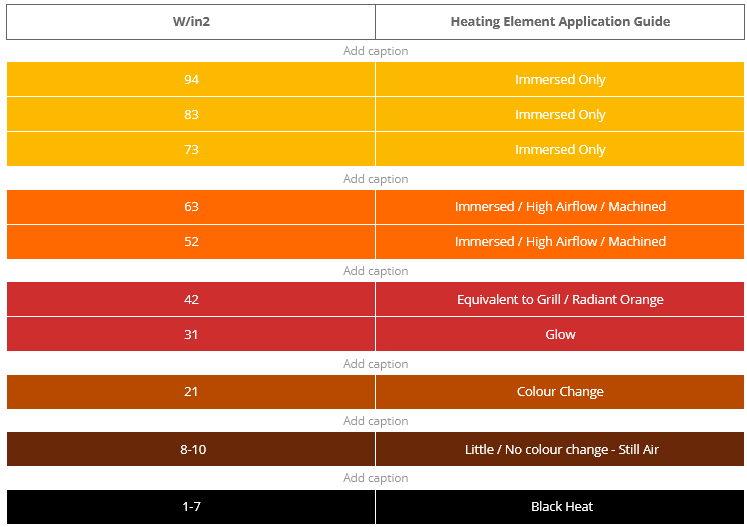Informational content provided by Jamie at immersionheaters.uk Call on 07897 246779.
I was going to provide a link to the best definition of watts density available on the web, but they are in very short supply, so here goes.
Watts density is the amount of heating energy emanating from any given amount of surface area of the hot part of an element.
In Imperial Britain and the States, this is usually described in terms of watts per square inch, but could be expressed (to keep the Eurocrats happy) as watts per square cm, mm, or indeed, meter. But why bother?
For 8mm diameter elements, simply divide the heating power output (in watts) of the given element by the length of hot section, ie. subtracting the cold ends at either end of the element, which can be 2″, 4″, 6″ or any custom length.
So, for the benefit of a simple example, if we have a 1kW, 54″ element with 2″ cold sections, we first take 4″ (2 ends of 2″) of cold off the total length of the element to give our hot section, 50″. Then we divide the power output of 1000w by 50″ to give us a watts density of 20w/in².
Now imagine we have a 1kW, 104″ element with 2″ cold ends (c/e), giving a hot length of 100″, do the maths as above, and you should get a watts density of 10w/in². Now, picture an inch square in your mind, or draw it if you prefer. Now, fill the box with 10 or 20 little boxes, happy faces, “watt monsters”, whatever crumbles your cookie. The size of the square doesn’t change between the 2 examples, but the size of the contents do, more watts per square inch means more squashed, little watts trying to get out of the same space. Now draw a box, mentally or on paper, and squeeze 40 of your little watt icons in that box. While your at it, have think about how long a 1kW element with 2″ c/e, would need to be to give a watts density of 40w/in²?
For the less imaginative among you, somebody kind drew this –

Different watts densities are requires for different applications. Some are set in stone, for obvious reasons, such as oil heaters needing to be no more than 12w/in², others are a little more flexible and open to “interpretation”. ElementYoda always told me 5w/in² for elements in still air, but as can be seen below, grill elements can work at up to 42w/in². Fortunately, we don’t supply many of them, cos there wouldn’t be much of a guarantee at that top end. We are mainly suppliers of immersion heaters for water, with soft water being fine between 50-75w/in², but hard water being better suited to 40w/in² or below.
Our (Element Air) EA Range is rated at 27w/in², designed for forced air heating units, where the airflow needs to be 2m³/s. The simple way this is achieved is that every meter of element equates to 1kW, so if you want 3kW you have to bend/coil a 3m element into your available space.
Below is a detailed table of watts density in inches and equivalent cm, plus details of colour change and suitable applications.
| W/in2 | W/cm2 | |
| 94 | 14.5 | Immersed only |
| 83 | 12.9 | Immersed only |
| 73 | 11.3 | Immersed only |
| 63 | 9.7 | Immersed / High Arflow / Machined Fit |
| 52 | 8.1 | Immersed / High Arflow / Machined Fit |
| 42 | 6.5 | Equivalent to Grill / Radiant / Orange |
| 31 | 4.8 | Glow Red |
| 21 | 3.2 | Colour Change |
| 10 | 1.6 | Little or no Colour Change Still Air |
| 9 | 1.5 | Little or no Colour Change Still Air |
| 8 | 13.0 | Little or no Colour Change Still Air |
| 7 | 1.1 | Black Heat |
| 6 | 1.0 | Black Heat |
| 5 | 0.8 | Black Heat |
| 4 | 0.6 | Black Heat |
| 3 | 0.5 | Black Heat |
| 2 | 0.3 | Black Heat |
And for the visual learners among you, here is that same info in colourful form that I “borrowed” from a friend –

To convert to other element diameters, please divide your solution as above by the following factors. If you think of the 1kW, 54″ element with 2″ cold sections that we started with, only this one is 12mm in diameter, share our 20w/in² initial answer by the factor of 1.484, gives a watts density of 13.48w/in², which makes sense as a wider element will have more surface area for the 1000w to “escape” from.
| mm diameter |
FACTOR |
| 8 | 0.99 |
| 8.5 | 1.05 |
| 9.5 | 1.175 |
| 10 | 1.24 |
| 11 | 1.36 |
| 11.5 | 1.42 |
| 12 | 1.484 |
| 12.7 | 1.57 |
| 13.4 | 1.657 |
| 16 | 1.98 |
| 20 | 2.474 |
| 50.8 | 6.28 |
When you understand all this, and realise that glowing ain’t good, you can see the sense in squeezing as much element into the space available, cos simply put, the lower the watt density, the longer it’ll last, whatever it is heating.

Thanks for visiting, please leave a comment.
Informational content provided by Jamie at ImmersionHeaters.UK or 07897 246779.